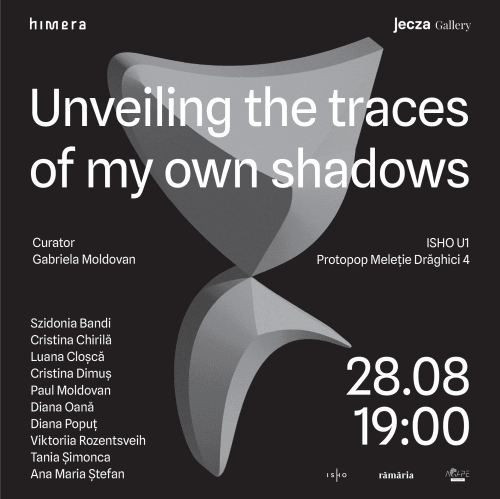„The absent present” is not merely an illusion or an effect of perceptual blindness, and materiality does not present the absolute truth.
Unveiling the traces of my own shadow presents a well curated collection of visual artists such as Ana Maria Ștefan, Szidonia Bandi , Cristina Chirila, Cristina Dimuș, Diana Oană, Moldovan Paul Darius, Luana Cloșca, Diana Popuț, Rozentsveih Viktoriia, Tania Șimonca each of whom, through painting, graphics, photography, sculpture and ceramics, embody the play of the „absent present”.
Following the traces we leave throughout life and the shadow of our own selves, these lead us to a journey of introspection and reflection on our human identity. In this context the „trace” represents the imprints left by our experiences, while „shadow” suggests the subtle and also invisible presence that shapes.
The manifestation of absence through an intangible figure is inevitable. The exploration and revelation of one's own lights and shadows involve constructing this figure from fragments. By uniting these divisions, the exhibition builds an "absent presence," a human presence that comes into being in the borderline space between the visible and the invisible, yet never fully reveals itself. This complex and multidimensional figure, around which the entire exhibition revolves, is not formed through direct representations but through the subtle and abstract contributions of each artist. The works present fractions without fully defining an aspect of the individual—whether it be memory, emotion, desires, or ancestral connections. The uncertainty and obscurity of this distinct figure make their presence felt behind the shapes, colors, and shadows, emanating an energy that fills and dominates the entire space.
We identify this “absent presence” in each work of the exhibition. It is found in the assumed absence of the human figure, where the void is filled with geometric or vegetal motifs as in the series Axis Mundi by Ana Maria Ștefan, or in the cactus metaphor by Szidonia Bandi. The void is also filled by the element of memory, as seen in the works of Tania Șimonca, Viktoriia Rozentsveih, and Cristina Dimuș. We see a timid trace of the figurative, a representation of human anxiety and alignment in the works of Cristina Chirilă, but the peak is seen in the “flight” of characters identified in the works by Luana Cloșca, where the intense and fleeting stroke outlines our mystical character. The magnetism conveyed by Paul Moldovan through sculpture, a force that is difficult for the eye to perceive, as he states, or the phenomenon of perceptual blindness, manifests as the glue, water, and ash of this recurring absence. Ultimately, the body of work is completed by the exploration of the phenomenology of absence, as Diana Popuț embraces in her pieces, these latter works filling the void we sense as a shadow throughout the exhibition.
Absence, a concept developed by Jean-Paul Sartre in his work Being and Nothingness published in 1943, implies that it is not just a simple lack or void, but an essential part of how we experience everyday life. Sartre argues that absence is always connected to desire and intention. Absence is not just a mere physical lack but transforms into a subtle presence in our mind, influencing how we live and perceive a situation. Thus, absence transforms from a mere void into an active force, capable of shaping our experiences and revealing profound meanings about the world.
In this sense, the exhibition does not only present the absence of a human figure but suggests that this absence has its own presence, one that is subtle but powerful. The human figure, an absent presence, moves from the metaphysical field to the physical one, but in a fleeting manner, its presence being uncertain. Through the exhibited works, the artists manage to make visible what is invisible, creating a space where what is missing becomes just as important as what is present. Thus, the exhibition challenges the viewer to think beyond the surface and to sense those aspects of human existence that, although they cannot be touched or seen, profoundly influence the perception of reality and leave a strong imprint on the Self.
- text by curator Gabriela Moldovan
